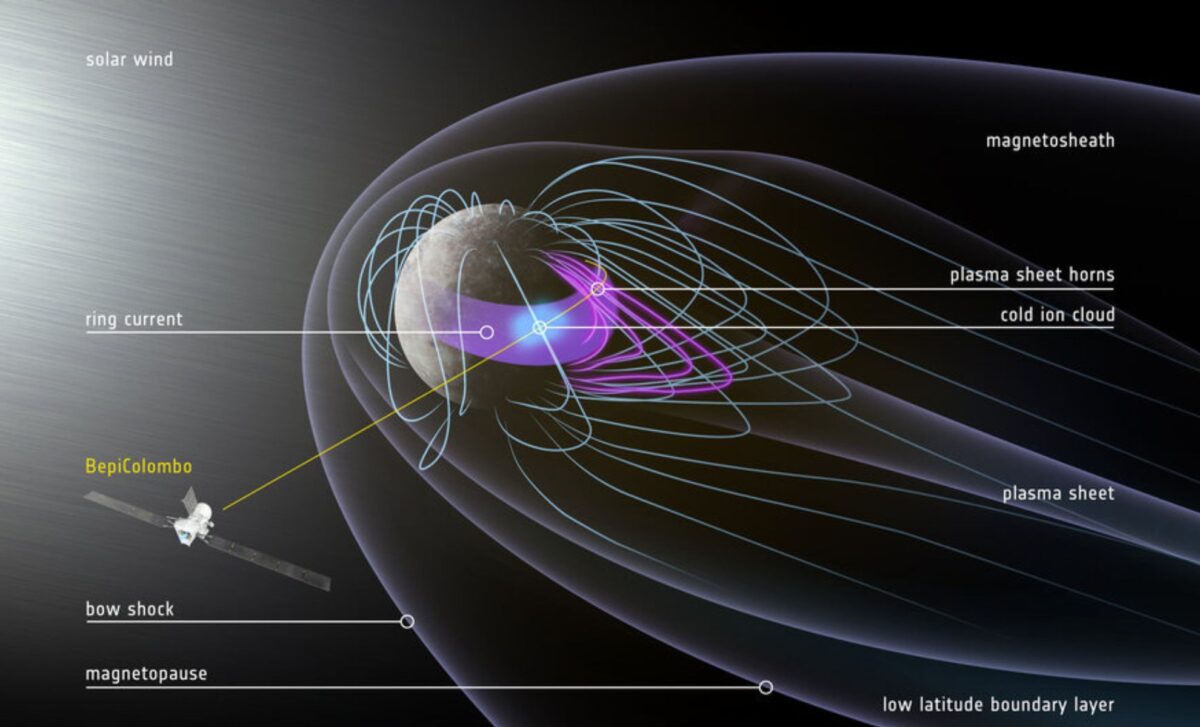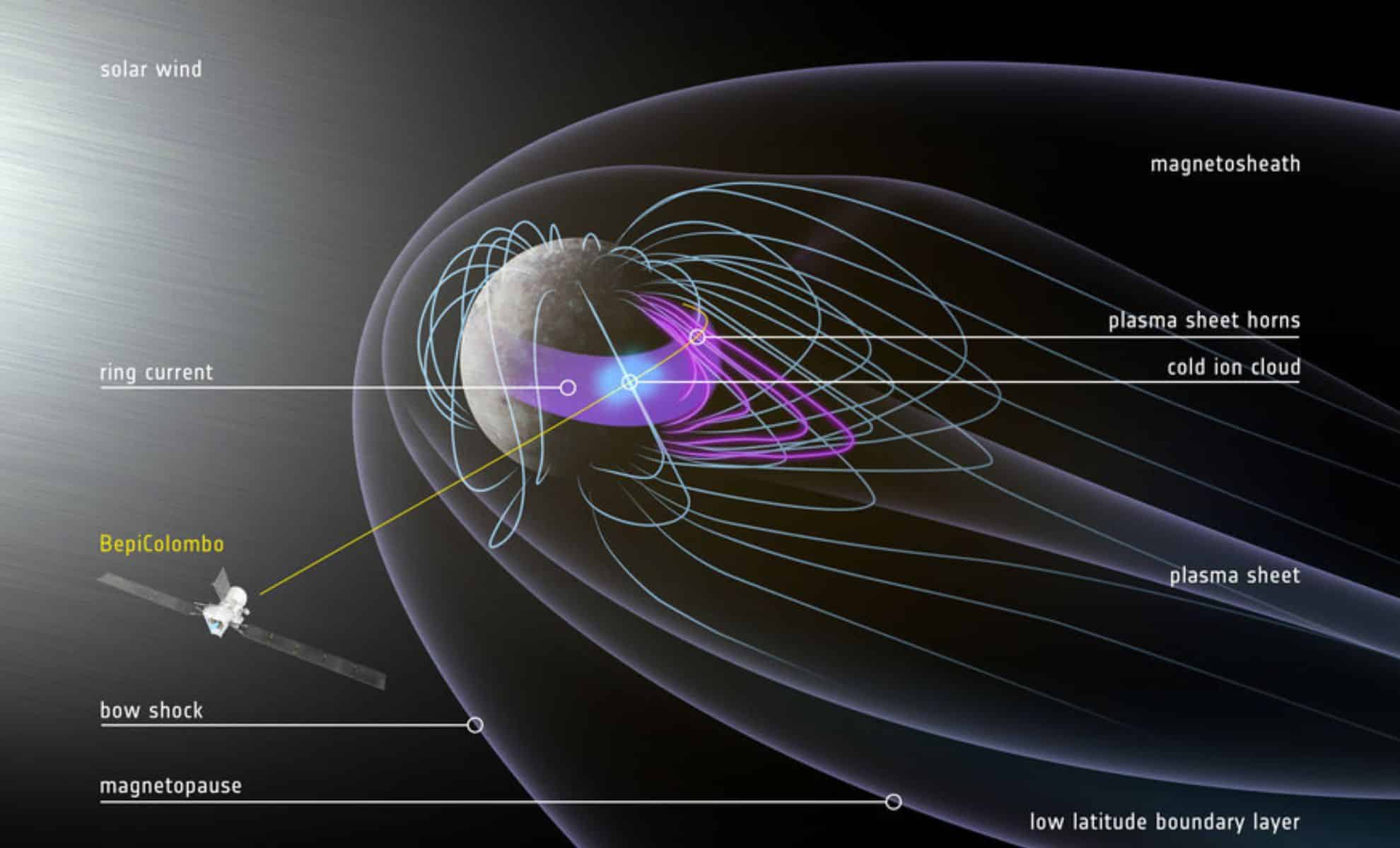ESA and JAXA’s BepiColombo spacecraft has made significant discoveries during its third Mercury flyby, revealing surprising magnetic features such as energetic hot ions and potential ring currents. These findings are giving scientists a preview of the mission’s full scientific potential when the spacecraft enters Mercury’s orbit in 2026.
BepiColombo’s Mercury Flyby Unravels Mysteries of the Planet’s Magnetic Field

The BepiColombo spacecraft, a joint mission between the European Space Agency (ESA) and the Japan Aerospace Exploration Agency (JAXA), is shedding new light on Mercury's magnetic field.
During its third flyby of the planet in June 2023, BepiColombo gathered critical data, helping scientists unravel the mysteries of the planet’s magnetosphere—a much weaker version of Earth’s magnetic bubble. Though BepiColombo is not yet in its final orbit around Mercury, these flybys are already offering a fascinating glimpse into the dynamic magnetic interactions around the solar system’s smallest and innermost planet.
Mapping Mercury’s Magnetic Landscape in Just 30 Minutes
Mercury, much like Earth, has a magnetic field, albeit about 100 times weaker than Earth's at the surface. This weak field still carves out a protective magnetosphere that shields the planet from the solar wind, a stream of charged particles constantly blowing from the Sun. However, due to Mercury’s proximity to the Sun—just 36 million miles away—its magnetosphere faces a much harsher and more intense bombardment by these solar particles compared to Earth’s.
During the June 2023 flyby, BepiColombo traversed Mercury’s magnetosphere in a rapid 30-minute window, moving from dusk to dawn and flying just 235 kilometers (146 miles) above the planet’s surface. This brief encounter allowed the spacecraft’s scientific instruments to sample the types of particles present, measure their temperatures, and observe their movements, all of which helped map the magnetic environment surrounding Mercury.
As Lina Hadid from the Laboratoire de Physique des Plasmas at Paris Observatory, who worked on the data, explained, “These flybys are fast; we crossed Mercury’s magnetosphere in about 30 minutes... enabling us to clearly plot the magnetic landscape during this brief period.” The data collected during this short encounter is providing critical insights into how Mercury’s magnetic field interacts with the solar wind, paving the way for deeper exploration when BepiColombo reaches its final orbit in 2026.

Surprising Discoveries in Mercury’s Magnetic Bubble
BepiColombo’s flyby confirmed several expected features of Mercury’s magnetosphere, including the shock boundary where the solar wind meets the planet's magnetic field, as well as the plasma sheet, a stream of hot, dense, electrically charged gas trailing behind the planet. However, the spacecraft also uncovered some unexpected surprises.
One of the most intriguing discoveries was the detection of energetic hot ions trapped near Mercury’s equatorial plane, which may indicate the presence of a ring current in the planet’s magnetosphere. Ring currents are a type of electric current carried by charged particles that become trapped in a planet’s magnetic field. On Earth, ring currents exist tens of thousands of kilometers above the surface, but Mercury’s compressed magnetosphere—which is squashed close to the planet by the intense solar wind—raises questions about how particles could be trapped so close to the surface, just a few hundred kilometers up.
Hadid, who is also co-investigator of the Mercury Plasma Particle Experiment (MPPE) suite, remarked on the significance of this discovery: “We also observed energetic hot ions near the equatorial plane and at low latitude trapped in the magnetosphere, and we think the only way to explain that is by a ring current... but this is an area that is much debated.” The existence of such a ring current on Mercury could challenge current theories about how magnetospheres function in such extreme environments.
In addition to this, BepiColombo’s instruments also detected turbulent plasma at the low-latitude boundary of Mercury’s magnetosphere, a region where the solar wind interacts directly with the planet’s magnetic field. According to Dominique Delcourt, the former lead of the Mass Spectrum Analyzer on BepiColombo, this turbulent region revealed particles with an unusually broad range of energies, unlike anything previously observed at Mercury. “We detected a so-called low-latitude boundary layer... and here we observed particles with a much wider range of energies than we’ve ever seen before at Mercury,” Delcourt explained.
Linking Mercury’s Surface to Its Plasma Environment
One of the most exciting revelations from the flyby was the detection of ions of oxygen, sodium, and potassium in Mercury’s exosphere. These elements are likely ejected from the planet’s surface by meteorite impacts or solar wind bombardment, and the particles were captured by BepiColombo’s instruments as it passed through the shadow of Mercury. When BepiColombo moved out of the Sun’s direct light and into the shadow, it became possible to detect these ions as the spacecraft itself cooled and became less electrically charged, allowing the detection of colder, heavier ions.
Delcourt described the process as almost seeing the planet’s surface composition in three dimensions. “It’s like we’re suddenly seeing the surface composition ‘exploded’ in 3D through the planet’s very thin atmosphere, known as its exosphere,” he remarked. This detection offers new insights into how Mercury’s surface interacts with its magnetosphere, linking the planet’s physical makeup with the plasma environment that surrounds it.
Looking Ahead: The Promise of Future Discoveries
The June 2023 flyby was just one of six planned Mercury flybys that will help refine BepiColombo’s trajectory and offer a preview of the science to come when the spacecraft reaches its final orbit. According to Go Murakami, JAXA’s BepiColombo project scientist, this dusk-to-dawn sweep across the planet’s magnetosphere is only a “taste of the promise of future discoveries.” The flybys provide unique opportunities to observe regions of Mercury’s magnetosphere that may not be accessible once the spacecraft is in its permanent orbit.
With two more flybys scheduled for December 2024 and January 2025, BepiColombo is expected to continue uncovering the secrets of Mercury’s magnetic field and surface interactions. The mission’s full potential will be unlocked when the spacecraft’s two scientific orbiters—the Mercury Planetary Orbiter (MPO) and the Mercury Magnetospheric Orbiter (Mio)—begin their joint operations, painting a complete picture of the dynamic space environment around the solar system’s smallest planet.
As Geraint Jones, ESA’s BepiColombo project scientist, noted, “The observations emphasize the need for the two orbiters and their complementary instruments to tell us the full story... we can’t wait to see how BepiColombo will impact our broader understanding of planetary magnetospheres.”



